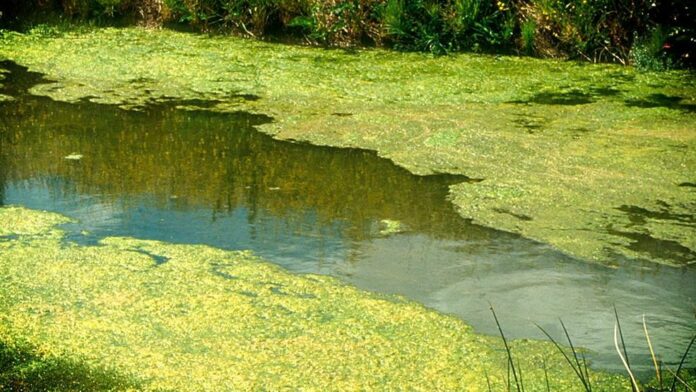Do you have a neglected mine pit in your farm or vicinity that water collects into unsightly ponds? Well, you are sitting on a gold mine – and, not know it. Especially for poultry farmers.
A stagnant pool of water, often gets covered with surface weeds. This is the Azolla Weed, commonly known as the duckweed. It’s the birds’ favorite delicacy, and for a reason.
Duckweeds, and other pond-dwelling plants are nutritious – direct product of eutrophication. This is defined as ‘excessive richness of nutrients in a lake or other body of water, frequently due to run-off from the land, which causes a dense growth of plant life’.
This is a sign of heavy nutrient inflow.
How can a farmer purposely farm and harvest this protein?
- You’ll need a pit that can hold water for long stretches of time. Preferably, a natural one. Water weeds thrive best in a natural pit, with virgin soil. Alternatively, make a pond. Like, a fishpond.
In daily speak, it’s basically a solar-powered, protein factory.
- Harvest the protein.
It’s an easy chore. Fabricate net baskets off some poles. Just skim the weeds off the surface of the pond. Like, you’d fish a piece of onion floating on chicken soup on your plate.
Feed the weeds (protein) to ducks, chicken, turkeys – instantly, meat and egg productions shoot.
- Due to high surface area of green cover – water may be “low in oxygen at lower levels”. Especially at night. By day, Sunlight does not penetrate. That means lower plants may be dying, or minimal.
- Reduce surface cover to 25% by harvesting said protein – as light penetrates, algae and plants at the bottom come up and start producing oxygen. The more you harvest, the more they thrive as pond conditions improve. Keep harvesting weed and feeding chickens and ducks.
- From inception of the project, harvest the duckweed every 2-3 days. With a healthy eco-system, a pond takes 2-3 months to stabilize. Then in Mnth4… introduce 1,000 Tilapia and 300 catfish fingerlings.
Additional value addition ideas for the reclaimed pond
- In the 4th month, introduce fingerlings, mixed species. In this case, go for Catfish and Tilapia fingerlings. Depending on the size of the pond, calculate a ratio based on the formula: 300 Catfish to 1000 Tilapia. Basic arithmetic, right?
The Catfish will ensure the tilapia grow to a bigger size by eating the smaller ones.
- Monitor the fingerlings. Sample their size at intervals. Harvest the fish at 500gm live weight. This size is roughly ‘plate size, and popular in restaurants and local eateries.
- Point to note: Make certain to capture ALL the catfish… or, next season you’ll be floored to discover no Tilapia in the pond. Catfish never misses dinner.
By removing the plants and fish, you are now removing nutrients from the pond and your pond will be more productive… because light is hitting the bottom.
When you introduce the fingerlings, make nightly visits to the pond, at 2-hour intervals. Observe the surface. If the fish seem to be at the surface gulping air to stay alive…..there’s air deficiency. There’s need to aerate the pond.
Install a solar battery-powered pump system that aerates water through the night. Make observations, and adjust accordingly.
That’s how to reclaim an unsightly pond – and make millions from the project.
Credits: Nawaz Khan (research)








